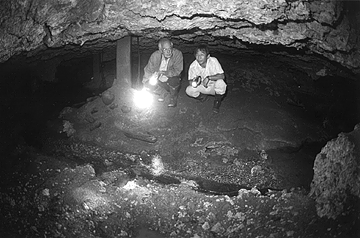
Former Star-Bulletin reporter Phil Mayer, left, and Chester Lao
of the Board of Water supply check out a stream in a Moiliili cavern.
Star-Bulletin file photo

Former Star-Bulletin reporter Phil Mayer, left, and Chester Lao
of the Board of Water supply check out a stream in a Moiliili cavern.
Star-Bulletin file photo
Beneath the streets, homes and businesses around King Street and University Avenue lies a network of caverns and underground springs from which have sprung countless stories of fact and fantasy.
Oldtimers remember when the Standard Trading store, located just about where Central Pacific Bank in University Square is, actually "just fell in." This was in 1952.
Even earlier, Sidney Kashiwabara, who grew up in Moiliili, remembers "three separate locations where the ground gave way, leaving gaping holes in which we could enter and explore the subterranean caverns below Moiliili."
One was makai of University and King; another "in the back of Kanda store in the heart of Moiliili Town (about where 7-Eleven is today); and the other, "on Nakookoo Street, where Mr. Idemoto lived," said Kashiwabara, now 76.
On one of his underground explorations as a boy, he made sure to carry a spool of string, which linked him to the outside. He vividly recalls seeing carp swimming in underground tidal pools.
Chester Lao, a geologist with the Honolulu Board of Water Supply, has researched this subterranean network, noting both the legends and scientific facts of the origins of the caverns - which are not lava tubes, but formed by fresh ground water from Manoa Valley flowing through limestone reefs.
One legend, for example, is that fish beneath Moiliili would overhear fishermen planning their trips and swim out to sea to warn their friends. "The implication is that the cavern system was connected to the sea," Lao said. "Although the presence of mullet might have suggested this connection, mullet can easily flourish in mildly brackish water and could have been transplanted at some earlier time."
Lao believes the underground fish came from a surface source, such as the old Willows restaurant pond, and adapted over the years to their sunless environment.
He was part of a group that explored a cavern (don't ask where because officials don't want the location publicized), in 1983, paddling on foam boards. The part they saw was four to 10 feet high and the water perhaps five feet deep in spots.
Although most of the dramatic sinkings occurred decades ago, there is evidence in more recent years of the land settling, Lao said.